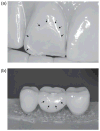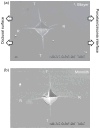Residual stresses in porcelain-veneered zirconia prostheses
- PMID: 22578663
- PMCID: PMC3393788
- DOI: 10.1016/j.dental.2012.04.019
Residual stresses in porcelain-veneered zirconia prostheses
Abstract
Objectives: Compressive stress has been intentionally introduced into the overlay porcelain of zirconia-ceramic prostheses to prevent veneer fracture. However, recent theoretical analysis has predicted that the residual stresses in the porcelain may be also tensile in nature. This study aims to determine the type and magnitude of the residual stresses in the porcelain veneers of full-contour fixed-dental prostheses (FDPs) with an anatomic zirconia coping design and in control porcelain with the zirconia removed using a well-established Vickers indentation method.
Methods: Six 3-unit zirconia FDPs were manufactured (NobelBiocare, Gothenburg, Sweden). Porcelain was hand-veneered using a slow cooling rate. Each FDP was sectioned parallel to the occlusal plane for Vickers indentations (n = 143; load = 9.8 N; dwell time = 5s). Tests were performed in the veneer of porcelain-zirconia specimens (bilayers, n=4) and porcelain specimens without zirconia cores (monolayers, n = 2).
Results: The average crack lengths and standard deviation, in the transverse and radial directions (i.e. parallel and perpendicular to the veneer/core interface, respectively), were 67 ± 12 μm and 52 ± 8 μm for the bilayers and 64 ± 8 μm and 64 ± 7 μm for the monolayers. These results indicated a major hoop compressive stress (~40-50 MPa) and a moderate radial tensile stress (~10 MPa) in the bulk of the porcelain veneer.
Significance: Vickers indentation is a powerful method to determine the residual stresses in veneered zirconia systems. Our findings revealed the presence of a radial tensile stress in the overlay porcelain, which may contribute to the large clinical chip fractures observed in these prostheses.
Copyright © 2012 Academy of Dental Materials. Published by Elsevier Ltd. All rights reserved.
Figures




References
-
- Kelly JR. Dental ceramics: what is this stuff anyway? J Am Dent Assoc. 2008;139 (Suppl):4S–7S. - PubMed
-
- Harder S, Wolfart S, Eschbach S, Kern M. Eight-year outcome of posterior inlay-retained all-ceramic fixed dental prostheses. J Dent. 2010;38:875–81. - PubMed
-
- Kawai K, Urano M. Adherence of plaque components to different restorative materials. Oper Dent. 2001;26:396–400. - PubMed
-
- Piconi C, Maccauro G. Zirconia as a ceramic biomaterial. Biomaterials. 1999;20:1–25. - PubMed
-
- Crisp RJ, Cowan AJ, Lamb J, Thompson O, Tulloch N, Burke FJ. A clinical evaluation of all-ceramic bridges placed in UK general dental practices: first-year results. Br Dent J. 2008;205:477–82. - PubMed
Publication types
MeSH terms
Substances
Grants and funding
LinkOut - more resources
Full Text Sources

